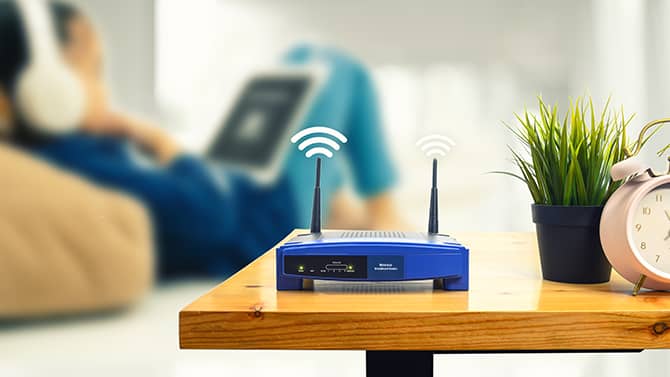Your Wi-Fi network is the digital front door to your home—and if it’s not secured, you might as well leave that door wide open. From personal files to banking data and smart home devices, everything is vulnerable if your network isn’t properly protected. Knowing how to set up a secure home Wi-Fi network can prevent identity theft, device hijacking, and other digital disasters.
Let’s walk through the essential steps to keep your Wi-Fi locked, loaded, and hacker-proof.
The Dangers of an Unsecured Wi-Fi Network
An open or poorly protected network can lead to:
-
Unauthorized access to your devices
-
Data theft and identity fraud
-
Eavesdropping on internet activity
-
Malware injection or ransomware attacks
-
Reduced bandwidth from freeloaders
A weak Wi-Fi network puts your entire digital life at risk.
Change the Default Network Name (SSID)
Your router comes with a default SSID (network name), often revealing the brand and model—useful information for hackers. Change it to something unique that:
-
Doesn’t include personal info
-
Isn’t tied to your address or name
This makes it harder to target your specific setup.
Create a Strong and Unique Wi-Fi Password
Your Wi-Fi password should be:
-
At least 12 characters long
-
A mix of uppercase, lowercase, numbers, and symbols
-
Not reused anywhere else
Avoid using default or easily guessed passwords like “password123” or “homewifi.”
Use WPA3 Encryption (or WPA2 at Minimum)
Encryption scrambles the data traveling over your network. WPA3 is the most secure option available as of 2025. If your router doesn’t support it, use WPA2—but never use WEP (it’s obsolete and easy to crack).
Find this setting in your router’s wireless security options.
Change the Default Router Admin Credentials
Every router has an admin dashboard, usually accessed via your browser. The default login is typically “admin/admin” or “admin/password.”
Change both the username and password to something strong and unique to prevent unauthorized changes to your network settings.
Enable the Router Firewall
Most routers come with a built-in firewall. It adds an extra layer of protection by monitoring and blocking suspicious incoming traffic.
Check your admin dashboard and ensure the firewall is enabled.
Disable WPS (Wi-Fi Protected Setup)
WPS lets you connect devices with the push of a button or PIN. While convenient, it’s notoriously insecure.
Turn it off in your router settings to reduce the risk of brute-force attacks.
Use a Guest Network for Visitors and Smart Devices
Separate networks mean:
-
Your main devices stay isolated
-
You limit access if the guest network is compromised
Set up a guest network with its own strong password and give it to friends, family, and smart devices like doorbells or TVs.
Update Router Firmware Regularly
Firmware updates fix bugs and close security holes. Some routers update automatically, while others need manual checks.
Log in to your router’s admin panel and look for a “Firmware Update” section.
Limit Remote Management Features
Many routers allow remote access for convenience. Unless you need this feature, turn it off. If enabled, it can allow hackers to alter your settings from anywhere.
Use MAC Address Filtering (Optional)
This lets only approved devices connect to your network. While not foolproof, it’s a good layer of extra security.
You can find the MAC address in each device’s network settings, then add it to your router’s whitelist.
Turn Off Unused Features (UPnP, Port Forwarding)
Features like UPnP (Universal Plug and Play) make things easier—but also open doors for hackers if not configured correctly.
Unless you need them, disable unnecessary services to shrink your attack surface.
Physically Secure Your Router
Keep your router in a safe, central location. Avoid placing it:
-
Near windows (where signals can leak)
-
In shared or easily accessible spaces
This prevents someone from physically resetting or tampering with your router.
Monitor Connected Devices Regularly
Most routers let you see all connected devices. Log in regularly to:
-
Identify unknown devices
-
Block unauthorized users
-
Check bandwidth usage
If something looks suspicious, change your password immediately.
Use a Network Monitoring Tool or App
Apps like Fing, GlassWire, or your router’s own app can:
-
Alert you to new device connections
-
Block intrusions
-
Help you manage your Wi-Fi better
Knowledge is power—and protection.
Enable Automatic Device Updates Where Possible
Smart TVs, thermostats, speakers, and even lightbulbs are mini-computers. Enable automatic updates to patch vulnerabilities as soon as they’re discovered.
Educate Household Members
Even with top-tier security, one mistake can compromise your network. Teach your family:
-
Not to share the Wi-Fi password publicly
-
How to identify phishing scams
-
The importance of logging out of accounts
Security is a shared responsibility.


